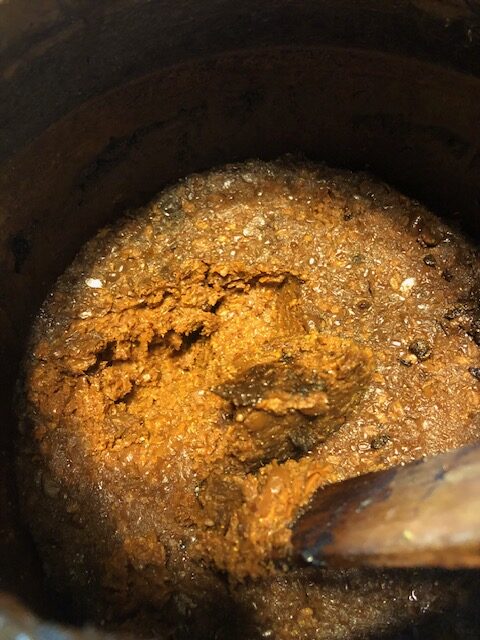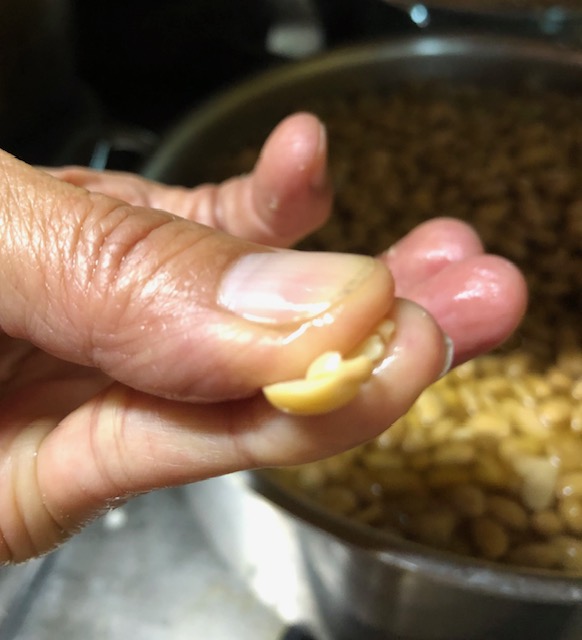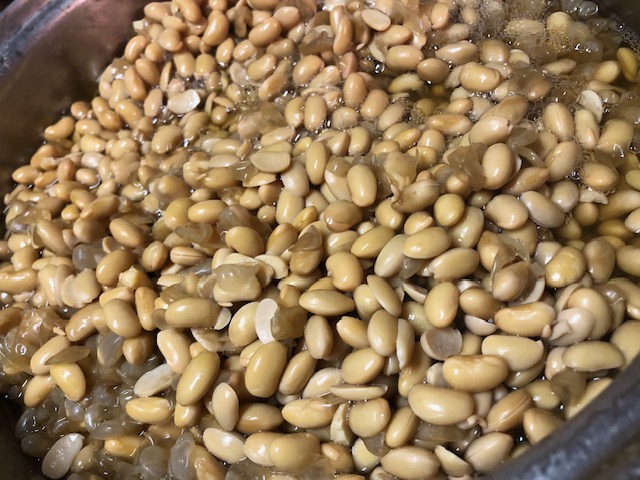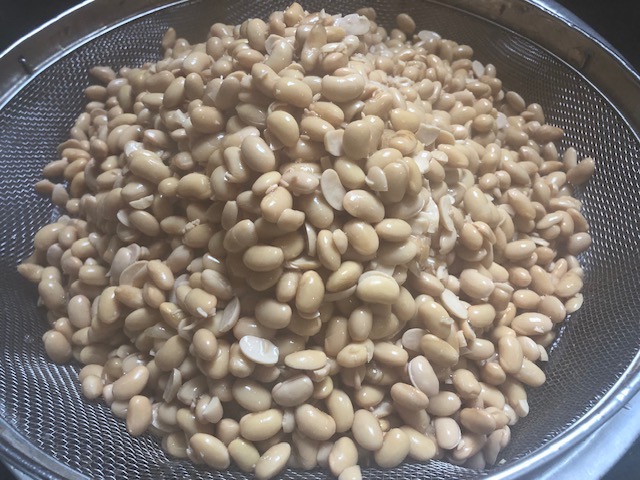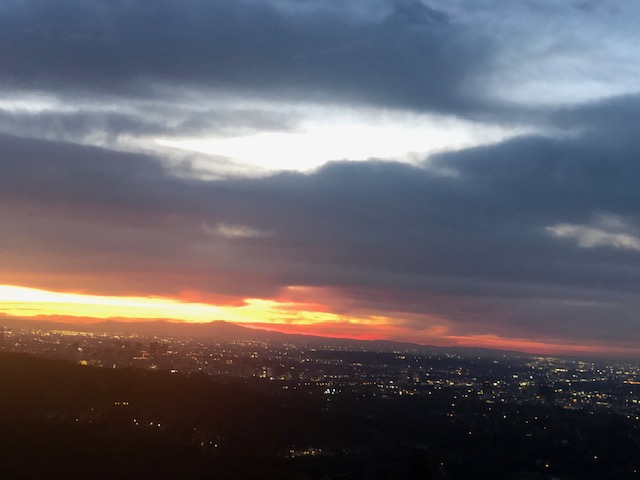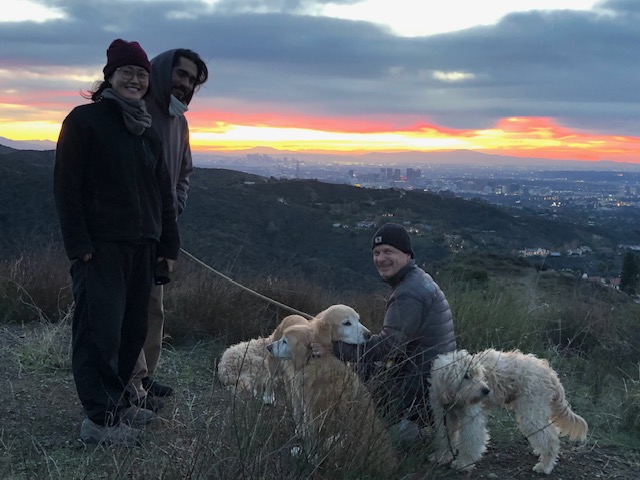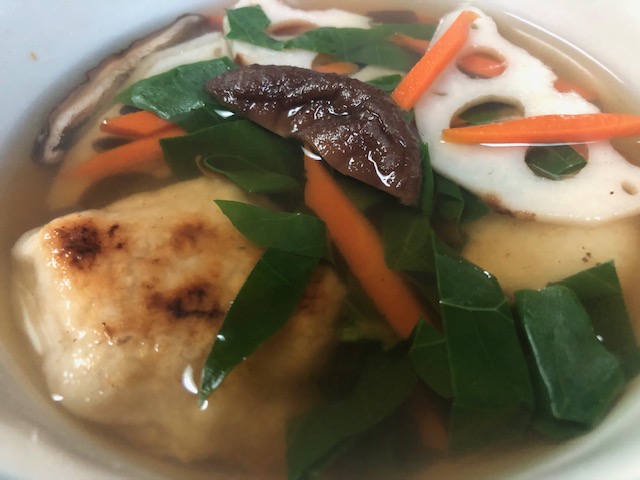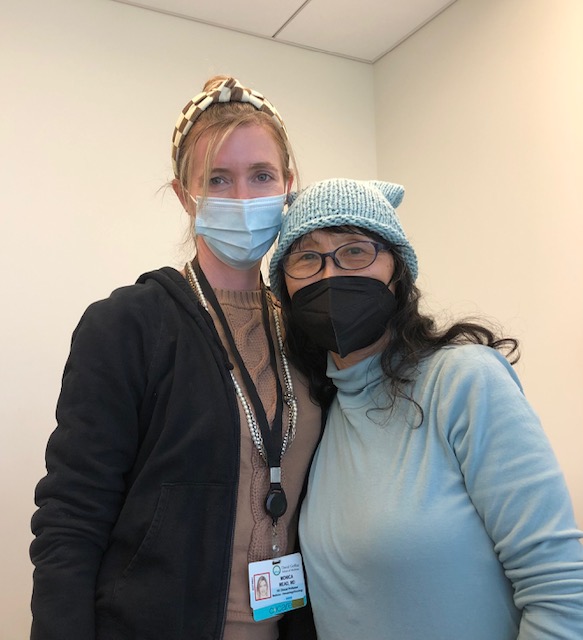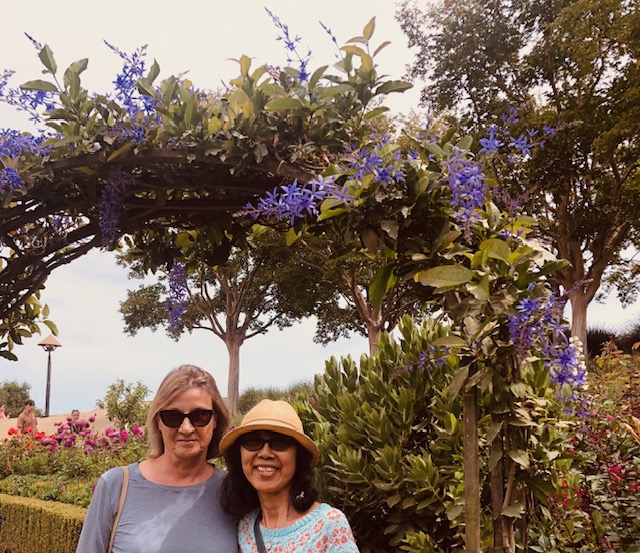
After five days of rain and wind storms last week, the sun was shining brightly, and the blue skies reflected it.
Usually, I would feel refreshed by the sunshine and blue skies, but my heart was still in darkness as the storm continued.
My beloved dog granddaughter, Happy, who was always by my side, suddenly became unwell and passed away to heaven on the last day of the rainstorm. Just writing this makes me feel a tightening pain in my chest.
My heart is aching, and I have empty, hollow feelings.
I am not ready to write about Happy much.
All I can say now is…Happy was my big-hearted, kind, tolerant, and sweet dog granddaughter.
She was always by my side, like my shadow.
She followed me even if I just went to the next room to get something.
When he couldn’t see me, he wandered around looking for me.
I feel like a ghost now, without a shadow.
I only remember a little of what I did the day she departed seven days ago.
*Seven days is call “Shonanoka” in a Buddhist service held on the seventh day after death. This is when the deceased crosses the River Styx (4000km – 2485.485 miles wide) after she passes 3200km/1988.388mile long steep mountain. Depending on her behavior during life, the stream of the river will change. So, the deceased’s family gather and honor her, sharing good memories and thoughts so that she will receive a gentle stream. I wrote about it on my blog
https://sanaesuzuki.com/2016/08/09/kula-golden-retriever-life-with-her-cancer-part-4/
I started to look at Happy’s most recent photos and Videos. Unfortunately, I did not have many photos of Happy in the last six months. I only took one photo with her (that’s the cover photo).
I was taking more photos of Lumi (Happy’s mom) because she is older and has health issues, so I thought Lumi was going to heaven sooner than Happy.
I wanted to see Happy’s photos of when she was a puppy, but it was too painful so I could not do it.

Happy left, Lumi (Happy’s mom) and me New Year’s day 2024
Even though I had studied animal communication, animal behavior, nutrition, and animal spiritual energy for many years, I did not notice that Happy was not feeling well.
It was a shock. I should have known if she had the health condition.
Now that she’s gone, I feel overwhelmed with guilt.
I also felt so bad for Happy’s mother, Lumi, who could not look at and come close to Happy after Happy died.

Three other Happy’s family all looked sad but came close to her and Snif.

I wanted to set up an altar for Happy with the Buddhist traditional “Goku (Five basics),” offering incense, lanterns, flowers, food, and purified water.

Happy’s color was orange, so Eric and I went to the local flower shop with Kai (Happy’s nephew), even though it was still raining a little bit, to get orange flowers.

I set up the altar with a candle, incense, orin (Buddhist bell), water, her favorite blueberry cookies with flowers, etc. I lit the candle and incense, rang the bells, and prayed.
I don’t even remember now what I worshiped. I only remember that I just put my hands together (gasshou).
After that, I put on the music that Happy and I had been listening to, cried a lot, and meditated together for an hour.
I hugged Eric and the dog and cat family over and over again.
On the second day, the Sun came out powerfully, as if so much rain was a lie.
I was moving mechanically, not wanting to do anything.
But when I looked at all of Happy’s family, I took them out for a walk as usual without thinking. The first walking team is Happy’s mom, Lumi and Happy’s nephew, Kai.
Happy used to walk with them, so my heart was not there with me, and the deep inside of me was numb, but I felt that Happy was walking with us.
When I returned home, there was a voice message from a *CSC (Cancer Support Community) blood cancer member that she wouldn’t be at the Zoom meeting, so if I was going to be there, she wanted me to let the group know.
*The CSC (Cancer Support Community) Blood Cancer group, which I joined about seven years ago when I got stage IV Lymphoma Cancer.
It has been helping me to hear what other people are going through physically and emotionally with their blood cancer and get more information about treatments, hospitals, oncologists, etc.
I was trying to decide if I was up to be on Zoom/seeing other people.
I wanted to see how my long-time friend, John, was doing after his last chemotherapy. Ironically, John came to see me when I was taking chemotherapy for stage IV lymphoma, and three years later, he got lymphoma. I invited him to join the CSC’s Blood Cancer meeting, and he has been attending.
I knew the Zoom meeting had started, and time was passing. My heart said, I want to attend the Zoom meeting.
I clicked on Zoom connection. Previously, when I was late joining the meeting, I did not get a call to share till the end of the meeting, but the facilitator asked me how I was doing after the person speaking when I joined.
I was not expecting to share so soon; I did not know what to say.
My breath caught, and I checked. I had to think for a moment about what to say.
I said, “One of the members of CSC left a voice message to ask me to convey the message, and I also wanted to see how John is doing…”
I started crying and said, “I am sorry, I am not myself today….”
I corrected what I said and continued, “Actually, I am myself.”
I took a deep breath and said, “My dog daughter, Happy, passed away about 24 hours ago.”
My tears came down, and I could not stop crying. I felt my heart was aching.
The pain that feels like my chest is being torn apart.
I took another deep breath.
“I am grieving and feeling guilt for Happy that I may not have done the right things for her needs since I thought her mother, Lumi, was going to die before her, and I was focusing on Lumi more than Happy in the last six months.”
“I am so sorry, Happy!”
I blew my nose, then said,
“I am in so much pain, and tremendous sadness of tsunami is coming into my whole being.”
When I lost someone, including an animal family, during a previous grieving period time, I grieved so much. It must have lowered my immune system, and I got cancer twice.
One was after my father passed, I got ovarian cancer. The other one was 6 months after my beloved dog’s daughter, who was my service dog, Kula, passed, I got stage IV lymphoma.
So, I continue sharing on the Zoom CSC meeting.
“In the past, losing someone with whom I had strong connections and unfinished issues or regrets made my strength weak, and my immune system went lower.”
“I am grieving, and I have a fear of losing my health once again, so I need to look back at what I can improve to cope with grieving and self-care.”
As I looked back, I realized my experience of grieving has different shapes and colors depending on who passed away.
When my mother passed away, I was sad, and I grieved, of course, but I communicated with her to accept who she was and also let her know who I was to her before she passed away so I had peace later on.
Since living in America, I have sent a family of 16 animals to heaven.
Raising animals is not an easy task, and I was sad when they left.
But with the animal family that I was able to communicate with and connect with, grief was like a big wave in the ocean that I could surf, and I didn’t drown. I missed them and at the same time accepted their departure.
I looked back; how did I do when my father and Kula passed away?
When my father passed away:
I could not communicate with my father before he passed away.
I knew his health was not well, so I visited him one month before he passed away in Japan. I went to his favorite restaurant with my sister and we had a good time.
I called him at the airport before departing to return to America, but he did not answer and never called me back. His secretary said he was on a business trip so that he would contact me later, but he never did.
When I received a phone call three weeks later that he was in critical condition and went to see him in Japan the next day, he was already unconscious and passed away eight hours later.
I had to return to Japan to help my mother and deal with the situation at my father’s business company seven times in one year.
The extreme stress did not give me a space for me to grieve.
I got so exhausted.
Then, the following year, my first husband filed for divorce, and one of my dogs, whom I rescued on the street, died. Then, I had to foreclose my condo when I lost money on the divorce.
I was grieving and so much stress, but not knowing I was. I started to lose my health and got ovarian cancer.
When my beloved dog’s daughter, who was my service dog, Kula, passed away,
Eric (my current husband) and I tried to save our restaurant Seed Kitchen, but the landlord and realtor did not help us at all. We lost the lease, and the realtor sued us. We had to close the restaurant after Kula died.
Eric and I argued so much about the restaurant those days. I was focusing on accommodating the restaurant customers, employees, my students and clients.
I had no time for proper grieving till and for resting much. All I was doing was repairing our damage after closing the restaurant. Six months later, I got stage IV lymphoma.
The CSC facilitator asked me, “How do you not get sick/cancer from this grief?”
It is a good point for me to think and address the issues. Healthy grieving is facing the pain and dealing with it. It is work and no shortcut.
How do I do that?
I checked the blog I wrote about grieving in 2016 when Kula passed.
https://sanaesuzuki.com/2017/02/01/grief/
I was not aware of grief till much later since I was taking care of the restaurant we had at that time, and we lost it, so it was more than just losing Kula.
It took time to see that I was grieving over losing our restaurant, which had been one of our dreams.
Another was rebuilding my relationship with Eric after it got ripped off because of the stress of keeping and closing the restaurant.
We all have weak links in ourselves.
I realized my weakest link, which was when I lost someone, something that it meant to me and I could not accept, which led to grief, drained my immune system, and l lost my health.
This time, I admit that I am going through grieving as soon as Happy departure.
I am releasing my grief by connecting with “*Pet Loss Support Group” and starting to work on my healing journals.
*Pet Loss Support Group
https://www.lapoflove.com/our-services/pet-loss-support
I face the weakest point and need to change it to my strength.
Cry when I need to.
Work on guilt, regret, blame, fear, anger, and connection to forgive, especially me.
Softening the pain – talking to people who can support and respect my feelings and tell me the right words.
Writing is one of my tools to heal myself, so I want to write about how I give myself “Self-Care.”
Continue daily walking with the dog family, art, and gardening, being nature as usual.
Herbal tea and Bach flower remedies for sadness/grieving, moxibustion, reiki, massage, and herbal aroma baths, etc.
I take care of myself with a lot of “self-care.”

I planted Grevillea Superb (it has orange color flowers since orange was Happy’s color) bush tree (Happy loved a bush plant) in the front side garden with Eric.
I haven’t been able to communicate much with Happy since she passed away, but I heard her voice while I was planting Grevillea Superb.
“Mommy, what a beautiful flowers for me. I love the orange color!”
“I am happy that you decided that no surgery proceed and took me home from the cardiologist so I could go to heaven from the home where I was born.

Happy leaving the cardiologist’s office without surgery
I know you wished we had a little more time after we returned from the cardiologist, and me too. But my heart was not strong enough to live anymore.”
“I thank you so much for all you did;
I was the happiest dog since you were my everything and are the one I lived for.
I learned to spread joy and love because you gave me joy and love every day. “
“You taught me how to help heal other people.”
“I hope you continue to take care of your health and live a much longer life so I may return to be with you.”
“Right now, I am also shocked that I had to leave.
I know you are in shock and feeling guilty.
But Mommy, you looked at my face when I left; I was not in pain, and I was a beautiful girl as you always told me.”

Happy’s face right after she depatured
“You and Daddy took care of me so well.”
“I thank you so much!”
“I will see you again, either there on the earth or in heaven for sure, until we see each other again next time.”
“By the way, I am using my dog mom, Lumi’s body, to visit you, which you may have already noticed.”
“I heard you said, 「Lumi is getting up without our help and following everywhere I go, just like Happy.” (Lumi has arthritis and has not been able to get up on her own much)
“Lumi is sleeping soundless without snoring like Happy” (Lumi snored so much all the time while she is sleeping)) and “Lumi is drooling just like Happy when she wants something to eat and waiting.” (Lumi never drooled)
That’s right, Mommy, I am there with you in my dog Mom Lumi’s body.
Now you know how much I want to be there with you!”
” Thank you for cookies, clean water (Happy liked only clean water), candles, incense, and beautiful flower bouquets!
I am so blessed and loved because I am your girl forever!”
I looked up at the sky and hugged her spirit!
And told her,
“Happy- Arigatou!
You did a great job giving me and everyone joy, love, and happiness
I am so happy you came into my life.
Thank you for always being by my side!
I’m looking forward to seeing you again.”

I am so grateful that Happy communicated with me.
When I am ready, I want to write a tribute to Happy’s life: her story with photos. Set up a memorial in Happy’s honor.
Today is Happy’s first 7th day (*Shonanoka), so I would like to hold a memorial service for her in my own way.
*Shonanoka
Shonanona is a Buddhist service held on the seventh day after death. This is when the deceased crosses the River Styx (4000km – 2485.485 miles wide) after she passes 3200km/1988.388mile long steep mountain. Depending on her behavior during life, the stream of the river will change. So, the deceased’s family gather and honor her, sharing good memories and thoughts so that she will receive a gentle stream.
I post it on my blog
https://sanaesuzuki.com/2016/08/09/kula-golden-retriever-life-with-her-cancer-part-4/
My gratitude to Happy with all my heart!
Love,
Sanae ❤️











